In this article, we will provide answers to the following questions:
An overview of the pros and cons
Well, our song is almost over, so let’s summarize the facts and identify the pros and cons of ceramic-coated pans.
Pros:
- Looks stylish and modern, a large selection of modifications and colors
- It is easy to hold it, the hand does not get tired
- Oil consumption is minimal
Minuses:
- It is necessary to constantly be “on the alert” and not to touch it with iron shovels and cutlery.
- It cannot be washed with iron brushes, which is not always convenient and for the same reason it is quite problematic to remove carbon deposits.
- Ceramics cannot stand temperature extremes, which means that after taking out the pan with food from the refrigerator, you cannot put it to warm up. Also, do not drip cold water into a hot pan.
- It cannot be soaked in water for a long time, as the coating bursts. That is, the option is still not for lazy people, who have dirty dishes in the sink for days and wait for the owner’s inspiration.
- Well, the last argument is that she is dear. Even very expensive if you take a quality product from a trusted brand.
Why do you need such a frying pan?
Ceramic pans are becoming more and more popular.
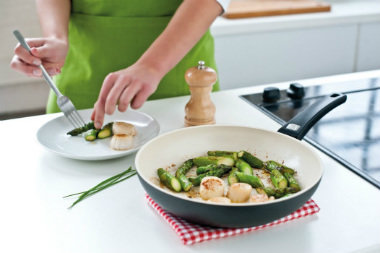
Someone chooses them because of environmental friendliness, someone because they can be fried on them without adding oil, and someone just likes their modern appearance and lightness. And on what your goal is – it will depend on whether such a choice is reasonable or not.
Let’s look at the most important reasons (and myths) that prompt a customer to run to the store for a new product, and you yourself will decide if you need it.
Perhaps everything is not at all what you would like and the extra expenses will be useless.
Is it true that food cooked in them is healthier because you don’t need fat?
The race for terribly harmful cholesterol is gaining unprecedented momentum!
Everyone wants to be healthy, which is not surprising in our age of total environmental pollution and low-quality food.
And against the backdrop of this panic, many inventors and manufacturers make good money, giving out under the guise of marketing “ducks” that only indirectly relate to the topic, but offend the masses for a living.
A simple example: A ceramic frying pan is a guarantee of health, since with it you will not consume excess cholesterol.
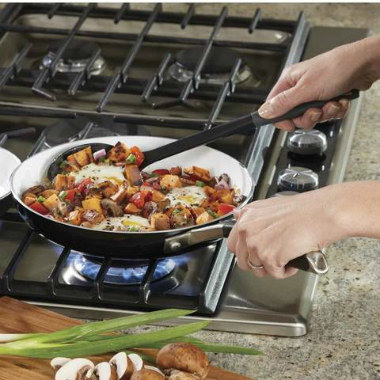
But what is so harmful in him?
Cholesterol – This is an organic compound, so to speak, a natural fatty alcohol contained in cell membranes.
We always have it in the body and 80% of the total cholesterol is produced by the liver, adrenal glands, intestines, kidneys, and gonads. And the remaining 20% come from food.
And if these necessary percentages are not enough, then the body will seriously “go nuts”, since cholesterol coming from the outside is directly related to the normal functioning of natural cholesterol, which is responsible for the smooth functioning of the immune system.
It is also essential for the production of vitamin D and hormones!
But the funniest thing is that cholesterol cannot accumulate in any way from the fact that you consume “extra” fats.
If the rate of cholesterol is “off scale”, then it is not the food that is to blame, but the failure in the exchange of fatty acids, which occurs for completely different reasons, moreover, from malnutrition and stress much more often than from regular overeating.
So if you want to buy a ceramic frying pan for this reason alone, you shouldn’t waste your money.
Moreover, if it comes to that, the harm of fried food is not in a large amount of fat, but in the crust itself, which contains carcinogens.
Is it true that they are more convenient to use, and there is practically no need for care?
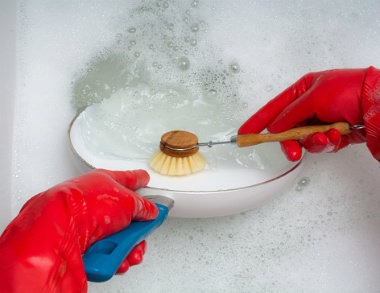
If you have very weak hands, then of course it is more convenient!
Modern pans are much lighter than cast iron ones. Few people manage to toss a pancake in an old grandmother’s pan and turn it over, but on a ceramic one – easily.
But what about leaving, then the question is very controversial…
If cast-iron pans can be mercilessly exploited, scratched, forgotten on a burning burner and even dropped, then such a number will not work with ceramics.
You need to treat them extremely carefully., since the coating bursts from temperature changes, scratches from abrasives and from this loses its properties.
Also, by no means do not use metal spatulasas the surface is damaged. Only rubber or wood.
And it turns out that caring for cast iron consists in periodically cleaning off carbon deposits (infrequent), but ceramic should always be monitored without relaxing.
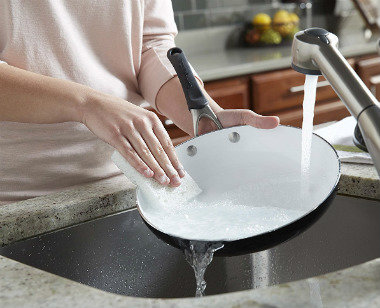
The most annoying thing is that carbon deposits also appear on it, but it’s more difficult to remove it, since abrasives are prohibited. If you want, you can read more about how to clean ceramic pans here: http://vashakuhnya.com/uhod/kak-ochistit-skovorodu.
But it is easier to wash them…
They are smooth and pleasant to the touch, like a plate. You don’t need to rub for a long time, everything lags behind, but in the case of cast iron, you need to make efforts.
Is it true that nothing sticks to them?
Sheer truth, does not stick even without fat.
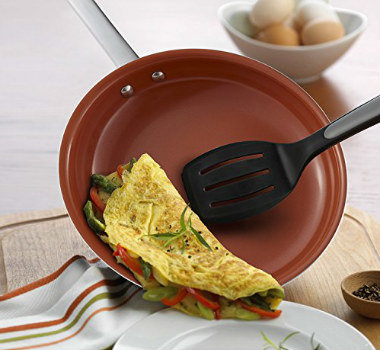
But first time! While the surface is perfectly solid. Then the effect comes to naught because the ceramic is covered with microcracks. And from the moment the bottom is damaged, even generously poured oil does not save.
Especially old ceramic pans “do not like” to “fry” potatoes. People complain that it just sticks tightly.
By and large, if you are ready for the fact that such a frying pan is not an eternal purchase, then why not buy it?
It deteriorates – you can take a new one, and that’s all. But for several years to enjoy the fact that food does not burn, does not stick and oil is consumed much more economically.
Does it emit harmful substances when heated?
But here it all depends on who produces the dishes.
And also, what is the quality of the ceramics, what is its thickness and what the base of the pan is made of. After all, they are completely different. But let’s talk about ceramic spraying for now.
What is the ceramic coating of a frying pan made of?
From clay, sand and polymers that bind them together and the base! However, manufacturers prefer to keep quiet about this. But, in fairness, reputable companies claim that they use extremely safe hardeners and catalysts, although it is rather difficult for a simple layman to check this.
So, manufacturers do not focus on the fact that there is a lot of chemistry and methyl acrylates in ceramic spraying.
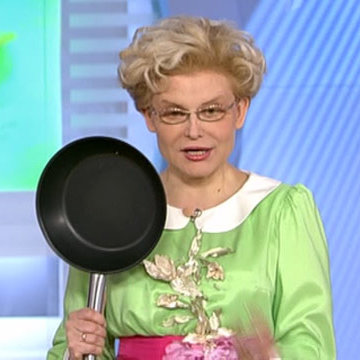
And at first glance, there is no harm from clay, solid environmental friendliness, and nothing more.
But from binders? Moreover, after the surface is damaged, when heated, harmful substances begin to be released from the base itself.
If it is made of high-quality cast iron, then there will be no harm. And if made of aluminum?
Then what’s the difference, take a coated pan for big money or a simple aluminum? Or, why not initially take cast iron? After all, nothing bothers him either.
So what is the conclusion?
If you want to buy a ceramic frying pan in order to become a little healthier, you shouldn’t.
But for the sake of saving oil, stylish look, quick washing and lightening of hands – why not?
What are the basics of ceramic pans?
As we mentioned above, ceramic pans come in different bases. It:
- Aluminum
- Cast iron
- Stainless steel
First option – the most inexpensive and the lightest frying pan on this basis.
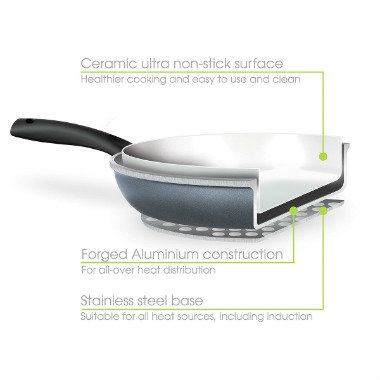
And it doesn’t have to be that aluminum is the worst choice. It’s about thickness.
If the pan is 2-3 mm, then it will be of poor quality, the spraying will quickly crack and the bottom will deform. But if you take 5-6 mm, then the product will last much longer, while it will not add much weight.
Cast iron base – it’s expensive and, frankly, absolutely pointless. All the same, it is in ceramic pans of the wrong thickness and hardening, as in grandmother’s options, and still, the pan will become unusable when the spraying is thoroughly cracked.
And no cast iron will save her from this process. The only thing that cast iron guarantees is uniform heating, on which the quality of food depends.
And yet, such dishes, after damage to the coating, can be cleaned in the workshop with a sandblasting machine, and then use an ordinary pan (if the thickness allows, since thin cast iron can burst from the pressure of sand).
Stainless steel has no advantages at all over aluminum and it makes sense to take it only if you are very afraid of aluminum fumes when heated.
What types of spraying are available for ceramic pans?
There are two methods: cheap and expensive.
The first – roll forward, the second – sputtering…
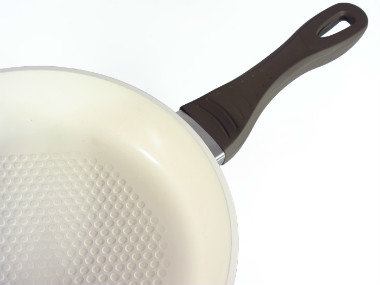
- 1. Rolling method involves applying a thin layer of ceramic to a solid sheet of metal, which then gets under a press, which squeezes out the pan. This method is simply adored by the Chinese, who show the world a lot of cheap and “eco-friendly” pans.
And when examining the product, you will definitely notice if the dishes are made in this way. The coating will have streaks and deformation. Do not take such pans, as their service life is at most a month.
- 2. Spraying it is applied to the finished pan, which makes the surface perfectly smooth. The alloy is not damaged anywhere and the dishes will last much longer.
It is difficult to judge about the very ceramic composition with which frying pans are coated. If you are not a chemist who is able to make an examination on your own, then you still won’t know the truth.
One thing we can say for sure: the coating should be without holes and preferably thicker, then the chance that the pan will last longer is increased.
What else to look for when buying?
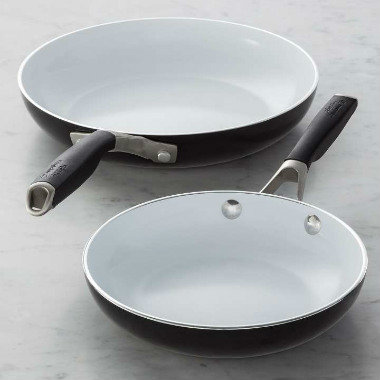
Be sure to pay attention on the handle… It should be heat-resistant and fit comfortably in your hand.
Also, an important role is played by cap… You should not take pans that are not equipped with it, since inconvenience awaits you in the future.
Also pay attention to tight fit of the lid and the presence of a valve on it for steam outlet… An ideal option is an opening valve that can be closed at any time (for example, if you need a long extinguishing).
But the most important thing is warranty! If there is no guarantee for the product, then it is better to refuse such a purchase, because the manufacturer tells you in plain text: I myself do not know how long my frying pan will last.
Why don’t you listen?
Which company to choose?
Well, let’s consider the last question: if you buy frying pans with a ceramic coating, which company is better?
According to reviews on the network, the following brands have proven themselves the best:
- Brener (Germany)
- Maestro (Russia)
- Ballarini (Italy)
But, these are the best of the best. There are many other worthy manufacturers on the market, among which Italians are in the lead.
What do their owners say about ceramic pans?
And here you can see with your own eyes what the people say in the reviews. After all, the opinion of the consumer is much more honest and interesting than the most tempting advertisement from the lips of a specially trained manager.

In conclusion, I would like to say that if buying ceramics for you is an expensive pleasure and you save up for it for a long time in order to purchase a product of a famous brand, then you should not fool your head. The best brand for all ages is “cast iron”!


